Glass Mansions
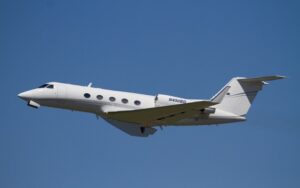
On its final approach to the Winnipeg Airport, Safeway’s company jet glided through the air smoothly, as always. I sat in a plush leather bucket-seat facing forward. The CEO sat across the aisle to my left. A Senior Vice President sat directly behind the cockpit, facing us. The cockpit door was open with a curtain drawn across it. We couldn’t see the pilot and co-pilot, but we heard the drone of their conversation with air traffic control.
The three of us from Safeway were chatting amiably when something hit us mid-air. There was a loud thud; the plane shuddered; and the pilot screamed.
I flinched and clenched the arms of my chair. The executive facing me looked like she’d been punched in the gut, and the CEO let out a muffled cry. The plane dipped forward. The engines sputtered, skipped a few beats, then caught hold again, and the jet leveled off, resuming its gradual descent. The entire incident consumed only a few seconds, just long enough for my life to pass before me.
“Everything all right?” the CEO said to the cockpit, his voice shaking.
“We’re good,” the co-pilot said.
“Valerie?” the CEO said.
“Sorry for the outburst.” Her voice was calm, reassuring. “We hit a goose. Bloody mess on Greg’s windshield, but we’re fine. We’ll touch down safely in a few moments.”
The CEO didn’t look convinced. I wasn’t either, but the pilot was true to her word. In less than a minute, we were coasting to the terminal.
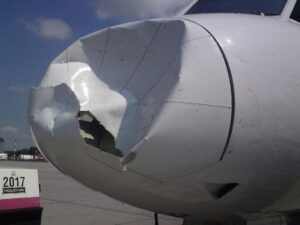 Standing on the tarmac, I looked up at the face of the jet. A basketball-sized gash dented the nosecone. Blood, entrails, and feathers covered the co-pilot’s windshield. Winnipeg is the capital of Manitoba, the Canadian province known as the land of a hundred thousand lakes. Thousands of geese flock to the lakes in the summer and pose a flight risk to aircraft on approach to the airport. The pilot said we were lucky. On one of her flights, a goose blew out the windshield and splattered innards all over the cockpit.
Standing on the tarmac, I looked up at the face of the jet. A basketball-sized gash dented the nosecone. Blood, entrails, and feathers covered the co-pilot’s windshield. Winnipeg is the capital of Manitoba, the Canadian province known as the land of a hundred thousand lakes. Thousands of geese flock to the lakes in the summer and pose a flight risk to aircraft on approach to the airport. The pilot said we were lucky. On one of her flights, a goose blew out the windshield and splattered innards all over the cockpit.
Practicing law and serving as a Safeway executive, I was a passenger on scores of private jet flights. Other than the goose collision, they were all serious mood-enhancers. No crowds to fight. No lines. A car drives you right up to the plane. It takes off when you’re ready. The cabins are spacious, luxurious, and comfortable. A steward serves Cabernet Sauvignon in crystal glassware and gourmet meals on fine china.
I’ve also flown more than three hundred commercial flights. When I worked at Safeway, I flew on Southwest Airlines cattle cars so often Southwest named me Burbank Airport passenger of the year three years in a row. All Southwest seats are coach class with passengers packed in like sardines. No reserved seating; first come, first served. More often than not, I was trapped in a middle seat, including an unforgettable adventure sitting between a three hundred pound guy spilling over my armrest and a young mother with a screaming baby in her lap. No gourmet meals on Southwest. I was lucky to get a Diet Coke in a plastic cup, and if the flight attendant liked me, two bags of fifteen peanuts each instead of the standard one bag per passenger. Given a choice, any sane person would choose to fly on a private jet rather than a Southwest 737 or any other commercial plane.
Unless that person is concerned about CO2 emissions. Private jets are big-time polluters on a passenger per capita basis. Because of the low passenger load, a private jet passenger generates somewhere between twenty and forty times the carbon emissions of a commercial passenger.
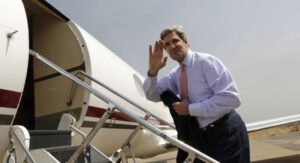
Based on that data, you would expect environmentalists to scream to high heaven for the abolition of private jet travel. There are some loud voices coming from lesser-known advocates, but most high-profile climate change reformers are wealthy private jet frequent-fliers. Living in glass mansions, they don’t throw stones.
President Biden’s climate czar, John Kerry, recently flew to Iceland on a private jet to accept an award for his work on climate change. The irony of his transportation mode was lost on him. “(I)t’s the only choice for somebody like me who is traveling the world to win this battle,” he said. “I believe, the time it takes me to get somewhere, I can’t sail across the ocean. I have to fly, meet with people, and get things done.” His explanation tellingly ignores commercial flights, as though that option doesn’t exist for “somebody like me.”
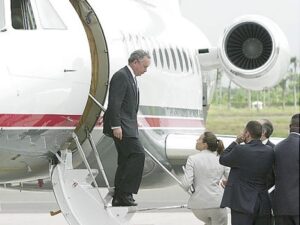
The United Nations recently reappointed Michael Bloomberg as its climate envoy. Bloomberg will fulfill his duties by traveling the world on his fleet of private jets. He does not see this as inconsistent with climate change reform. As a Bloomberg publication explains, “For many people, private jets seem like an extravagance. But for busy executives and celebrities, the time savings, convenience, and extra security they offer make them more of a necessity.” From 2016 to 2020, Bloomberg flew more than 1,700 such necessary flights, emitting more than 10,000 tons of carbon.
Bill Gates funds many worthy clean energy projects. He owns four jets, which he refers to as his “guilty pleasure.” In 2017, they spewed more than 1600 tons of carbon into the atmosphere.
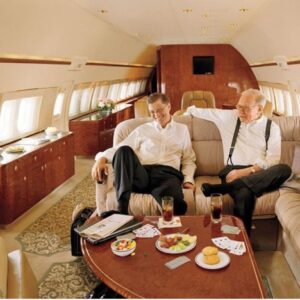
In 2019, the world’s A‑list of climate change luminaries flew 114 private jets to Italy to attend a summit on global warming organized by Google. Google executives own ten private jets, two Boeing airliners, and a fighter jet.
Some wealthy climate change advocates claim they offset private jet emissions by purchasing carbon credits. A Bloomberg article suggests convenient ways to do this. “You can offset a ton of CO2 by donating $18 to a reforestation effort in East Timor or by giving $15 to a program that provides fuel-efficient stoves for women in North Darfur.”
The accounting looks fishy, but even if it’s correct, you’d need to stack stoves ten high in every needy North Darfur kitchen to offset Bloomberg’s emissions alone. Besides, you would expect committed environmentalists to advocate accomplishing both goals simultaneously – funding the reduction of carbon emissions in poor nations while also greatly reducing air travel pollution by flying commercial. And yet, in researching this post, I found no wealthy environmentalist who set such an example.

This is not because flying private is a necessity for busy executives and celebrities, as Kerry and Bloomberg suggest. At Safeway, executives flew commercial before the company purchased the Gulfstream. It took more time; sometimes we had to bring along security personnel; and it was difficult to match our travel demands with commercial flight schedules. But we managed to work around the disadvantages and still achieve our goals.
Flying private is a willful choice based on convenience and comfort. Busy executives, celebrities, and wealthy environmentalists don’t want to fight their way through crowded airports, suffer indefinitely delayed take-offs, sit on planes with three hundred pound guys and screaming babies, miss connecting flights, and lose their luggage.

As someone who has flown too many miles on commercial flights, I get that. What I don’t get is the wealthy environmentalists’ presumption that they can lead the charge against global warming from a private jet’s plush leather seat while sipping Cabernet Sauvignon. Apparently, they think they can persuade the masses to make painful lifestyle changes while refusing to forego a luxurious “guilty pleasure” that produces carbon footprints thousands of times greater than that of the average person.
I don’t think so.
“Lead by example” is a time-worn maxim for a reason. If they want to change the world, park the jets.
Post Script: As Southwest Airlines Burbank Airport Passenger of the Year, my major award was a free Southwest flight to Chicago to an open-bar party. I couldn’t face yet another commercial flight even for free booze. I declined all three years.



 In 1975, a smallish bay foal with a weak bloodline and a slightly backward arc at his knees was born at a thoroughbred breeding farm in Lexington, Kentucky. Months later, in January 1976, my son was born in Los Angeles.
In 1975, a smallish bay foal with a weak bloodline and a slightly backward arc at his knees was born at a thoroughbred breeding farm in Lexington, Kentucky. Months later, in January 1976, my son was born in Los Angeles. I dropped everything and he and I moved into the Children’s Hospital of Los Angeles. The first night, his eyes swelled shut. I held him in my arms and tried to calm his fears. At dawn, diuretics mercifully flushed the water from his swollen face and he could see again, but the process didn’t stop there. The excretion of water continued for hours, relentlessly shrinking him down to a skeleton wrapped in pale gray skin as he screamed in pain from continuous muscle cramps.
I dropped everything and he and I moved into the Children’s Hospital of Los Angeles. The first night, his eyes swelled shut. I held him in my arms and tried to calm his fears. At dawn, diuretics mercifully flushed the water from his swollen face and he could see again, but the process didn’t stop there. The excretion of water continued for hours, relentlessly shrinking him down to a skeleton wrapped in pale gray skin as he screamed in pain from continuous muscle cramps. His improvement allowed him to sleep, so I wandered down the hall. I still can’t talk about the parents and kids I met, and with this post I’ve learned I can’t write about them either. The memories are too painful to confront. Survivor’s guilt plays a role, too. My son recovered. Many did not.
His improvement allowed him to sleep, so I wandered down the hall. I still can’t talk about the parents and kids I met, and with this post I’ve learned I can’t write about them either. The memories are too painful to confront. Survivor’s guilt plays a role, too. My son recovered. Many did not. Back at home, I gave my son the prednisone. It changed the shape of his face to resemble a cabbage patch doll with flushed chipmunk cheeks; he got chubbier; and he was moody and uncomfortable. After six weeks, we stopped the drug and his appearance and mood normalized. I tested his kidneys daily, dipping a plastic yellow stick in a urine sample. If it turned green, he was in trouble. Each day I was relieved when the stick stayed yellow, then immediately began worrying about the next one. I came to hate those sticks.
Back at home, I gave my son the prednisone. It changed the shape of his face to resemble a cabbage patch doll with flushed chipmunk cheeks; he got chubbier; and he was moody and uncomfortable. After six weeks, we stopped the drug and his appearance and mood normalized. I tested his kidneys daily, dipping a plastic yellow stick in a urine sample. If it turned green, he was in trouble. Each day I was relieved when the stick stayed yellow, then immediately began worrying about the next one. I came to hate those sticks.
 The sticks were still yellow in November when my son and I returned to the racetrack. To my surprise, the bay gelding was entered in a major stakes race. He still didn’t look like much to me, but the betting crowd made him the prohibitive favorite and my son picked him again.
The sticks were still yellow in November when my son and I returned to the racetrack. To my surprise, the bay gelding was entered in a major stakes race. He still didn’t look like much to me, but the betting crowd made him the prohibitive favorite and my son picked him again.
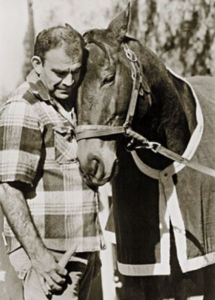

 The duck glided to a smooth landing in our swimming pool last May. Wild-eyed and frothing at the mouth, our American Bulldog Zoey ran back and forth along the sandstone skirt barking frantically while the duck paddled lazy circles in the water just out of her reach. After taunting Zoey for an hour, she flew away. The next several mornings she returned and the same scene played out.
The duck glided to a smooth landing in our swimming pool last May. Wild-eyed and frothing at the mouth, our American Bulldog Zoey ran back and forth along the sandstone skirt barking frantically while the duck paddled lazy circles in the water just out of her reach. After taunting Zoey for an hour, she flew away. The next several mornings she returned and the same scene played out. She was right on both counts. I found the nest tucked under bushes behind the pool. It sealed my fate. Disturbing a duck’s nest is a criminal misdemeanor in California. Once she drops an egg, her squatter’s rights are absolute. She owns the place until she decides to leave.
She was right on both counts. I found the nest tucked under bushes behind the pool. It sealed my fate. Disturbing a duck’s nest is a criminal misdemeanor in California. Once she drops an egg, her squatter’s rights are absolute. She owns the place until she decides to leave. Then everything changed. The morning of June 10 the duck led seven little furballs into the water. I’d never seen a baby duck up close. I stood by the pool and stared at them for a long time.
Then everything changed. The morning of June 10 the duck led seven little furballs into the water. I’d never seen a baby duck up close. I stood by the pool and stared at them for a long time. The day after they were born, mama duck marched them across the yard to the frog pond. An hour later, I found her standing beside our rail fence on a hillside struggling to maintain her footing. Trapped between chain link stapled to the fence to keep the dogs inside and the fine-mesh net that keeps the rattlers out, a duckling hopped around like a ping pong ball. It couldn’t get out and mama couldn’t free it.
The day after they were born, mama duck marched them across the yard to the frog pond. An hour later, I found her standing beside our rail fence on a hillside struggling to maintain her footing. Trapped between chain link stapled to the fence to keep the dogs inside and the fine-mesh net that keeps the rattlers out, a duckling hopped around like a ping pong ball. It couldn’t get out and mama couldn’t free it. I fell, which on that steep grade was like jumping out of an airplane backwards without a parachute. The fall didn’t kill me solely because the only tree on the hill stood fifteen feet directly below me. I landed on it, impaled face up, its broken branches spearing my back. Spewing a string of curses, I climbed down stiffly and clawed my way back up the slope.
I fell, which on that steep grade was like jumping out of an airplane backwards without a parachute. The fall didn’t kill me solely because the only tree on the hill stood fifteen feet directly below me. I landed on it, impaled face up, its broken branches spearing my back. Spewing a string of curses, I climbed down stiffly and clawed my way back up the slope. In the morning, only four babies swam with mama. One of those I’d saved was gone. I spent the day searching the yard, the slope, and the neighbor’s yard, all to no avail.
In the morning, only four babies swam with mama. One of those I’d saved was gone. I spent the day searching the yard, the slope, and the neighbor’s yard, all to no avail. Weeks passed. The baby grew to half mama’s size with the brown-speckled markings of a female mallard. In August, she took wing on her maiden flight, glided south, and bank-turned back to the pool.
Weeks passed. The baby grew to half mama’s size with the brown-speckled markings of a female mallard. In August, she took wing on her maiden flight, glided south, and bank-turned back to the pool. She stayed with us through August and September.
She stayed with us through August and September. door to go out to the pool for a closer look, the female scurried out of the water, ran all the way across the yard, stopped in front of me, looked up, and cocked her head to one side. “Quack!”
door to go out to the pool for a closer look, the female scurried out of the water, ran all the way across the yard, stopped in front of me, looked up, and cocked her head to one side. “Quack!”